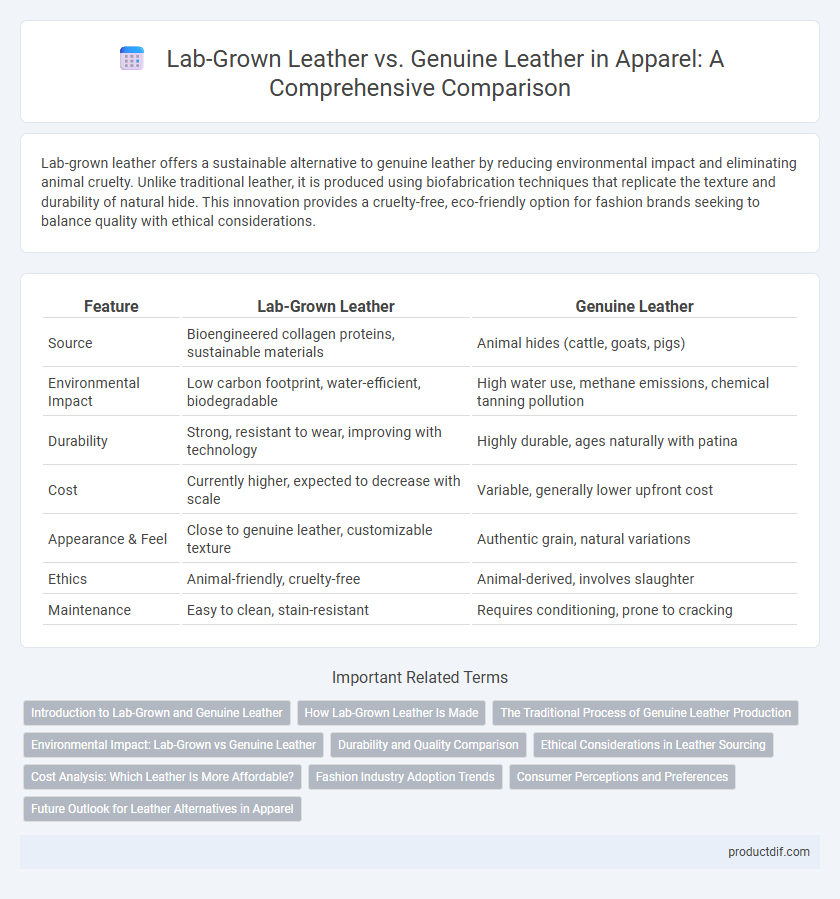Lab-grown leather offers a sustainable alternative to genuine leather by reducing environmental impact and eliminating animal cruelty. Unlike traditional leather, it is produced using biofabrication techniques that replicate the texture and durability of natural hide. This innovation provides a cruelty-free, eco-friendly option for fashion brands seeking to balance quality with ethical considerations.
Table of Comparison
| Feature | Lab-Grown Leather | Genuine Leather |
|---|---|---|
| Source | Bioengineered collagen proteins, sustainable materials | Animal hides (cattle, goats, pigs) |
| Environmental Impact | Low carbon footprint, water-efficient, biodegradable | High water use, methane emissions, chemical tanning pollution |
| Durability | Strong, resistant to wear, improving with technology | Highly durable, ages naturally with patina |
| Cost | Currently higher, expected to decrease with scale | Variable, generally lower upfront cost |
| Appearance & Feel | Close to genuine leather, customizable texture | Authentic grain, natural variations |
| Ethics | Animal-friendly, cruelty-free | Animal-derived, involves slaughter |
| Maintenance | Easy to clean, stain-resistant | Requires conditioning, prone to cracking |
Introduction to Lab-Grown and Genuine Leather
Lab-grown leather, also known as cultured leather, is created by cultivating animal cells in a lab to form a material that mimics the texture and durability of genuine leather without the need for animal hides. Genuine leather is derived from animal skins, primarily cows, through tanning and finishing processes that enhance its strength and aesthetic appeal. Both materials serve the fashion and apparel industry, with lab-grown leather offering a more sustainable alternative to traditional leather products.
How Lab-Grown Leather Is Made
Lab-grown leather is produced by cultivating animal cells in a controlled environment, allowing collagen fibers to develop into a material that mimics the texture and durability of genuine leather. This biofabrication process significantly reduces the environmental impact, eliminating the need for animal farming and tanning chemicals. Advances in tissue engineering enable scalable production of lab-grown leather with customizable properties ideal for sustainable apparel manufacturing.
The Traditional Process of Genuine Leather Production
The traditional process of genuine leather production involves several stages, including tanning, which stabilizes the collagen fibers to make the hide durable and resistant to decay. Vegetable tanning uses natural tannins from tree bark, producing leather with a distinct texture and color, while chrome tanning, more common in mass production, employs chromium salts for faster processing and softer leather. This time-intensive process requires significant water, chemical inputs, and energy, contributing to environmental concerns such as pollution and resource depletion.
Environmental Impact: Lab-Grown vs Genuine Leather
Lab-grown leather significantly reduces environmental impact by using fewer natural resources such as water and land compared to genuine leather, which relies on livestock farming that contributes to deforestation and greenhouse gas emissions. The production of lab-grown leather emits lower levels of carbon dioxide and generates less hazardous waste, minimizing pollution and soil degradation associated with traditional tanning processes. By offering a sustainable alternative, lab-grown leather supports eco-friendly apparel manufacturing and addresses critical issues of biodiversity loss and resource depletion inherent in genuine leather production.
Durability and Quality Comparison
Lab-grown leather exhibits high durability due to its controlled manufacturing process, ensuring consistent thickness and resistance to wear, often outperforming genuine leather in uniform strength. Genuine leather offers natural breathability and unique aging qualities, providing superior long-term comfort and developing a distinctive patina that enhances its aesthetic appeal over time. Quality assessments highlight lab-grown leather's eco-friendly production and customizable texture, while genuine leather remains favored for its traditional feel and resilience derived from natural fibers.
Ethical Considerations in Leather Sourcing
Lab-grown leather offers a cruelty-free alternative by eliminating the need for animal farming, significantly reducing the ethical concerns associated with animal welfare in traditional leather sourcing. Genuine leather production often involves animal slaughter and raises issues of environmental sustainability due to deforestation and greenhouse gas emissions linked to livestock farming. Choosing lab-grown leather supports a more sustainable and ethical apparel industry by minimizing animal harm and lowering the ecological footprint.
Cost Analysis: Which Leather Is More Affordable?
Lab-grown leather costs approximately $50 to $70 per square foot, making it moderately priced compared to genuine leather, which ranges between $40 and $100 per square foot depending on quality and origin. Production scale and raw material expenses heavily influence lab-grown leather's price, while genuine leather's cost fluctuates with animal farming, tanning processes, and supply chain variables. For budget-conscious consumers, genuine leather often remains more affordable, but lab-grown leather offers potential cost reductions as technology advances and manufacturing scales up.
Fashion Industry Adoption Trends
Lab-grown leather is revolutionizing the fashion industry by offering a sustainable alternative to genuine leather, which appeals to eco-conscious brands and consumers seeking cruelty-free materials. Major fashion houses and emerging designers increasingly incorporate lab-grown leather into collections to reduce environmental impact while maintaining luxury quality and durability. Trend analysis indicates a steady rise in investment and product launches featuring lab-grown leather, signaling a shift toward innovative, ethical fashion materials.
Consumer Perceptions and Preferences
Consumers increasingly favor lab-grown leather for its ethical appeal and environmental sustainability, perceiving it as a cruelty-free alternative to genuine leather. Genuine leather remains preferred for its durability, natural texture, and traditional craftsmanship, appealing to those valuing heritage and longevity. Market trends indicate a growing segment of eco-conscious buyers willing to invest in lab-grown leather despite higher costs, driven by concerns over animal welfare and carbon footprint.
Future Outlook for Leather Alternatives in Apparel
Lab-grown leather offers a sustainable solution to reduce the environmental impact of traditional leather production, with advancements in biotechnology enabling scalable manufacturing processes. Genuine leather, while valued for its durability and aesthetic, faces increasing scrutiny over ethical concerns and resource consumption, driving the demand for innovative alternatives. The future of apparel leather lies in the integration of lab-grown materials that combine ecological benefits with comparable performance, positioning them as a viable substitute in luxury and mass-market fashion sectors.
Lab-Grown Leather vs Genuine Leather Infographic

 productdif.com
productdif.com